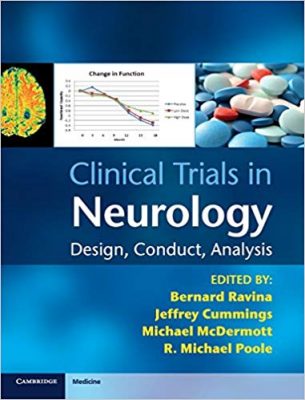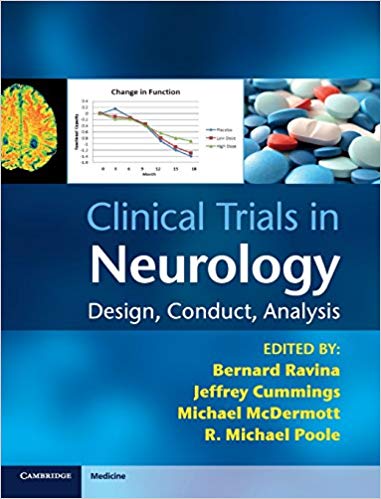 Editors: Bernard Ravina, MD; Jeffrey Cummngs, MD; Michael McDermott, PhD; and R. Michael Poole, MD
Editors: Bernard Ravina, MD; Jeffrey Cummngs, MD; Michael McDermott, PhD; and R. Michael Poole, MD
Publisher: Cambridge University Press – 369 pages
Book Review by: Sonu Chandiram
Next year (2020) a quarter of the workforce in the United States is expected to be 55 years old or older. This has been described by demographers as The Silver Tsunami that began after the end of World War II.
This age group is more commonly referred to as the Baby Boom Generation. They are expected to number almost 98 million people and comprise nearly 29 percent of the entire US population, a rise from around 25 percent in 2010. Studies have shown that brain-related ailments, diseases and disorders are more prevalent among older people, and the demand for health care professionals who care for the elderly has been growing.
This book focuses on the analysis of clinical trials needed to understand neurological disease and their progression. Its aim is “to improve the efficiency of clinical trials and the development of interventions in order to enhance the development of new treatments for neurologic diseases.”
What in essence, is a clinical trial?
The editors define it as “an experiment in humans that is designed to test a medical, surgical, biological, or other type of intervention.” They point out that a clinical trial does not presuppose a particular design, type of control group, or analysis plan.
So when you want design a clinical trial, use this book as your guide.
Forty-six specialists in neurology from all over the United States (including the four editors name above) and one from Canada authored the 29 chapters of this book that are organized around seven Sections. We name them below as an overview for you, of the contents:
- Section I – The role of clinical trials in therapy development
- The impact of clinical trials in neurology
- Sequence of clinical development
- Unique challenges in the development of therapies for neurological disorders
- Section II – Concepts in biostatistics and clinical measurement
- Fundamentals of biostatistics
- Bias and random error
- Approaches to data analysis
- Selecting outcome measures
- Section III – Special study designs and methods for data monitoring
- Selection and futility designs
- Adaptive designs across stages of therapeutic development
- Crossover designs
- Two-period designs for evaluation of disease-modifying treatments
- Enrichment designs
- Non-inferiority trials
- Monitoring of clinical trials: interim monitoring, data monitoring committees, and group sequential methods
- Clinical approaches to post-marketing drug safety approaches
- Section IV – Ethical issues
- Ethics in clinical trials involving the central nervous system: Risk, benefit, justice, and integrity
- The informed consent process: Compliance and beyond
- Section V – Regulatory Perspectives
- Evidentiary standards for neurological drugs and biologics approval
- Premarket review of neurological devices
- Section VI – Clinical trials in common neurological trials
- Parkinson’s disease
- Alzheimer’s disease
- Acute ischemic stroke
- Multiple sclerosis
- Amyotrophic lateral sclerosis
- Epilepsy
- Insomnia
- Section VII – Clinical trial planning and implementation
- Clinical trial planning : An academic and industry perspective
- Clinical trial implementation, analysis, and reporting: An academic and industry perspective
- Academic-industry collaborations and compliance issues
It is important for readers to know, as the editors write in the Preface and we quote them here: “There is no one trial design that meets all that meets all objectives for a particular phase of development. Rather there are parameters that need to be optimized for each intervention, question, and study.”
This work introduces you to the key concepts underlying trials in the neurosciences, especially if you are a clinical researcher in the pharmaceutical industry, neurologist, neuroscientist, neurosurgeon, psychiatrist or statistician.
This volume:
- Tackles the challenges of developing therapies for neurological disorders, such as: Measurement of agents in the nervous system
- Progression of clinical signs and symptoms
- Illustrating specific study designs and their applications to different therapeutic areas
- Covers key issues in phase I, II, and III clinical trials as well as post-marketing safety surveillance
- Discusses topics such as:
- Regulatory and implementation issues
- Outcome measures, and
- Common problems in drug development
In short, this is an excellent book on clinical trials particularly useful for the study of neurological disorders and diseases and their causes. So as we wrote earlier, when you want design a clinical trial, use this book as your guide.
Editors:
Bernard Ravina, MD is Medical Director of Translational Neurology at Biogen Idec in Boston, Massachusetts.
Jeffrey Cummings, MD is Director of the Mayo Clinic Lou Ruvo Center for Brain Health in Nevada, Ohio, and Florida.
Michael McDermott, PhD is Professor of Biostatistics and Professor of Neurology at Rochester University School of Medicine in Rochester, New York.
Michael Poole, MD is Head of CNS and Pain Innovation Medicine Unit at Astra Zeneca in Waltham, Massachusetts.







